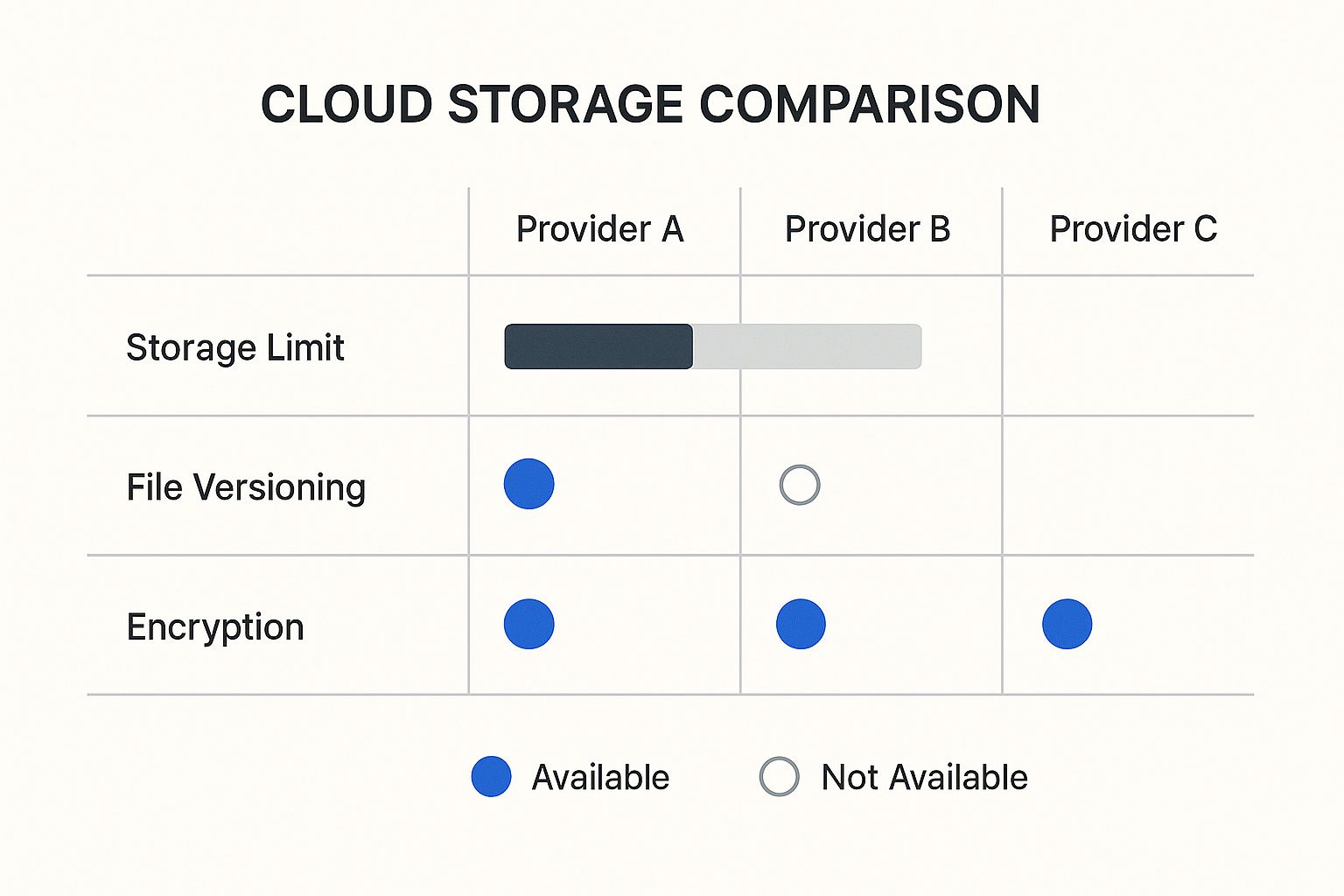Address
Australia, Singapore, and USA
Address
Australia, Singapore, and USA

Explore our cloud storage comparison to find the best provider for your international team. Compare features, security, and costs easily.
Picking the right cloud storage provider isn’t just about how much space you get anymore. When you’re running an international business, it’s a core decision that can either supercharge or bottleneck your entire global strategy. The best platform for you will come down to your team’s footprint, balancing tricky things like data residency laws, making sure teams can actually work together across borders, and delivering content that performs well locally. This guide provides a detailed cloud storage comparison tailored for businesses focused on international keyword strategy and global growth.

When your team is spread across the globe, your choice of cloud storage directly impacts how well you can operate. It’s the engine behind your international efforts, from delivering localized content on geo-targeted landing pages to supporting regional teams. Get it right, and collaboration is seamless. Get it wrong, and you’re staring down the barrel of compliance headaches, frustrating bottlenecks, and slow performance that kills your conversion optimization per region.
This isn’t just a theoretical problem. The global cloud storage market has exploded, jumping from around $132.03 billion to a projected $161.28 billion very soon. What’s driving that growth? The very same technologies that power international business—IoT, AI, and advanced analytics. This makes your storage decision more critical than ever. You can dig into the numbers and trends yourself in this detailed industry report.
For any business with an international presence, a few big names always come up. Each one brings something different to the table. We’re going to compare four major platforms through the lens of a global business:
Your cloud storage is the backbone of your international content strategy. It determines how quickly your teams can access and localize assets, which directly impacts your ability to engage and convert global audiences.
To give you a quick lay of the land, the table below offers a high-level snapshot of these platforms. Think of it as a quick reference to see where each one shines before we dive into the nitty-gritty details that matter for your international performance.
Here’s a quick summary of the top cloud storage platforms, highlighting their main strengths and the type of users they’re best suited for. This should help you get your bearings at a glance.
| Provider | Best For | Key Global Feature | Starting Price (Business) |
|---|---|---|---|
| Google Drive | Seamless real-time collaboration | Integrated G-Suite for international teams | $12/user/month |
| Dropbox | Fast large file sync and sharing | Block-level sync for quick remote updates | $15/user/month |
| OneDrive | Businesses invested in Microsoft | Native integration with Office 365 apps | $5/user/month |
| Sky Drive Folder | Geo-distributed teams and compliance | Geo-targeted content caching | Custom enterprise pricing |
This table provides a starting point, but the real decision comes down to the details. Now, let’s get into how each of these platforms performs where it really counts for a global business.

Choosing a cloud storage provider used to be a simple IT task. Not anymore. For any business with global ambitions, it’s a critical strategic decision that impacts everything from regulatory compliance to how fast your localized content loads for a customer halfway around the world.
The familiar features you see in tools like Google Drive or OneDrive are often born from intense competition at the enterprise level. Their parent companies—AWS, Azure, and Google Cloud—are constantly battling it out, and that’s great news for you. This rivalry fuels huge leaps in security, performance, and compliance, giving you more powerful tools to manage your international operations. It’s their race for dominance that improves the very networks your remote teams depend on.
One of the biggest shifts I’ve seen is the move away from putting all your eggs in one basket. Smart companies are adopting geo-targeted and multi-cloud strategies, not just to avoid getting locked into a single vendor, but as a calculated move for a real competitive advantage.
For example, a company might use one provider’s data centers in North America and a different one in the EU specifically to comply with GDPR. This isn’t just a backend decision; it directly affects your technical SEO for international reach, because server location and content delivery speed are huge ranking factors.
A multi-cloud approach isn’t just about risk management. It’s about strategically placing your data to solve for data sovereignty and deliver a faster, more localized user experience—a must for conversion optimization per region.
This isn’t a niche tactic anymore; it’s becoming the norm. The cloud storage market is expected to jump from $107.76 billion to $124.57 billion, largely driven by these new global demands. Consider this: about 89% of companies now use multiple cloud platforms, and nearly 80% have a hybrid cloud setup. This is a clear signal that flexible, region-specific data management is the future. For a closer look at the numbers, you can explore this comprehensive cloud industry report.
So, how does all this high-level strategy actually help your business? The connection is more direct than you might think. Your ability to run effective international marketing and sales campaigns hinges on the cloud infrastructure you choose.
Think about it in practical terms:
Managing all these distributed assets is a discipline in itself. A solid plan ensures your teams can find and use the right localized content at the right time. For a deeper look at organizing your digital files across different locations, check out our guide on effective cloud asset management. With this bigger picture in mind, we can now dive into how the major platforms stack up.
Picking the right cloud platform for a global team is about so much more than just a simple “cloud storage comparison.” You have to dig into how each service handles the unique pressures of international work. This breakdown focuses on what truly matters for teams spread across different countries: data residency, cross-border collaboration, security, and raw performance.
This chart gives you a quick visual summary of the key features from the top players, helping you see their core strengths at a glance.

As the infographic shows, while many platforms look similar on the surface, the real differences for a global business are buried in the details of how they deliver those features.
For any business creating multilingual or localized content for specific regions like the EU, data residency isn’t just a nice-to-have feature; it’s a legal must. How a provider handles data storage location has a direct impact on your ability to operate legally and build trust with local customers.
Google Drive, backed by the massive Google Cloud, gives you solid data residency options. Customers on its Enterprise and Education plans can pick specific regions (like Frankfurt or London) to store their data, which is a huge help for staying GDPR compliant. The catch? This is usually locked behind higher-tier plans, so smaller global teams might not get this feature without a major budget increase.
Microsoft OneDrive has a similar answer with its “Multi-Geo” feature for Microsoft 365. It lets a single company store its data across multiple geographic locations. For instance, your German office’s data can live in Germany, while your US team’s data stays in North America. It’s a powerful tool for big corporations but definitely adds layers of complexity and cost.
Dropbox has made moves to address this by offering data hosting in Germany, Japan, and Australia for its business clients. It’s a great step forward, but its regional choices are still more limited than what Google or Microsoft offer. This could be a dealbreaker for businesses targeting markets outside of those specific zones.
Sky Drive Folder comes at this from a different angle. It was built with a compliance-first mindset, giving you a straightforward dashboard to manage your data residency settings. This makes it much easier to line up your storage with geo-targeted landing pages and regional marketing campaigns, ensuring your customer data for a French campaign, for example, stays within the EU.
For an international business, the power to easily control where your data lives is non-negotiable. It’s the bedrock of a geo-targeted content strategy and is essential for both legal compliance and building trust with regional customers.
Smooth collaboration is the lifeblood of any team working across borders. Performance isn’t just about how fast a file uploads; it’s about the real-time experience of co-editing a document or grabbing a huge design file from the other side of the planet.
Google Drive shines here, mainly because of its seamless integration with Docs, Sheets, and Slides. The real-time co-authoring is famously fluid, making it a fantastic pick for teams that live in text-based documents and presentations.
OneDrive‘s main advantage is its deep connection with the Office 365 desktop and web apps. If your team runs on Word, Excel, and PowerPoint, the collaborative experience is nearly perfect for co-authoring even complex files across different regions.
But the real test comes when you’re juggling a mix of different tools and massive files. Our own internal tests of various cloud platforms have shown that a more specialized approach often gets better results. For a deeper look at what makes for a truly great collaborative tool, you can check out our detailed review of the top 12 cloud collaboration tools for 2025.
When your team is distributed globally, securing your data is a whole different ballgame. You need to know that your platform can handle threats from multiple regions and networks. This table breaks down the critical security and compliance features that are essential for international operations.
| Feature | Google Drive | Dropbox | OneDrive | Sky Drive Folder |
|---|---|---|---|---|
| Data Residency Controls | Yes, in specific regions for Enterprise/Education plans. | Yes, in select countries (Germany, Australia, Japan) for business plans. | Yes, with “Multi-Geo” add-on for Microsoft 365. | Yes, with a simple, user-friendly dashboard for all plans. |
| In-Transit Encryption | TLS | TLS | TLS | TLS |
| At-Rest Encryption | AES-128 bit (upgradable to AES-256 in some cases) | AES-256 bit | AES-256 bit (BitLocker for servers) | AES-256 bit |
| Zero-Knowledge Encryption | No | Available as an add-on for some plans. | No (Microsoft holds keys) | Yes, with end-to-end encryption, ensuring only you can access your data. |
| Key Compliance | GDPR, HIPAA, ISO 27001 | GDPR, HIPAA, ISO 27001 | GDPR, HIPAA, ISO 27001 | GDPR, HIPAA, ISO 27001 |
| Geo-Fenced Access | No (relies on broader IAM controls) | No | No (relies on broader Azure AD policies) | Yes, allows admins to restrict file access based on the user’s geographic location. |
| Ransomware Protection | Strong phishing/malware detection. | File recovery and version history. | Yes, includes Ransomware Detection and Recovery feature. | Strong versioning and admin alerts to help mitigate and recover from attacks. |
| Best For | Businesses deeply integrated into the Google Workspace ecosystem. | Creative teams needing fast sync for large files and simple sharing. | Large enterprises standardized on the Microsoft 365 and Office ecosystem. | Businesses needing tight security, compliance simplicity, and geo-specific controls. |
As the table shows, while all platforms offer strong baseline security, Sky Drive Folder’s inclusion of geo-fenced access and standard zero-knowledge encryption provides a level of control and privacy that is critical for global teams handling sensitive, localized content. It moves beyond just meeting compliance standards to actively helping you enforce them.
For an employee in Singapore who needs a file stored on a server in the US, sync technology is what separates a productive day from a frustrating one. The tech used to update and push files across long distances is a critical factor in any international cloud storage comparison.
Block-level synchronization is a key piece of this puzzle. Instead of re-uploading an entire file every time you make a small change, block-level sync only sends the parts (or blocks) that were actually edited. Dropbox is famous for its hyper-efficient use of this, which makes it incredibly fast for updating large files like videos or design mockups—a massive benefit for creative agencies with international clients.
Another vital component is a Global Content Delivery Network (CDN). A CDN keeps copies of your files in data centers all over the world. When a user requests a file, it’s served from the server closest to them, which drastically cuts down on lag.

A proper cloud storage comparison goes beyond a simple feature checklist. It’s about connecting those features to what really matters for a business: driving conversions. When your company operates globally, your storage platform has to do more than just sit there and hold files. It needs to be an active part of your international strategy, supporting everything from geo-targeted landing pages to regional marketing campaigns and enabling you to deploy different content types that drive global conversions.
The right provider becomes a silent partner in your conversion efforts. It makes sure your localized content loads quickly and reliably, which has a direct impact on user experience and builds trust. To see how this plays out in the real world, let’s walk through three common scenarios that businesses face when they expand internationally.
Imagine a marketing agency with teams spread across New York, London, and Tokyo. Their daily grind involves shuffling massive video files, high-resolution graphics, and localized content. Every second spent waiting for a file to download is a second lost, disrupting creative workflows and pushing back launch dates.
For this kind of setup, Dropbox often comes out on top. Its block-level sync technology is a game-changer. When a designer in Tokyo tweaks a 5GB video file, only the tiny changed portion gets synced—not the whole thing. This means the New York team sees the update almost instantly, allowing for incredibly fast feedback and iteration.
On top of that, its simple interface makes it easy to create shared folders for localized campaigns (like “Japan – Q4 Campaign”), keeping assets organized and accessible. This structure is a huge help for backlink building in target regions, as regional teams can quickly grab approved, localized content to share with partners. For anyone juggling projects across time zones, streamlining this process is everything. You can explore more options in our guide on the 12 best remote collaboration tools for global teams in 2025.
Now, picture a SaaS company based in California with a user base that’s exploding across Europe and Asia. Their biggest headaches are data sovereignty and performance. European customers are rightly concerned about where their data is stored, and slow load times for users in Asia could lead to them canceling their subscriptions.
In this case, Google Drive (as part of Google Cloud) is a very strong contender. Its enterprise plans give you serious control over data residency, allowing the company to store its European customer data inside EU data centers to comply with GDPR. This isn’t just about ticking a compliance box; it’s a powerful marketing message for geo-targeted landing pages aimed at privacy-conscious EU buyers.
Choosing a provider with clear regional data storage options is a direct investment in conversion optimization per region. It builds trust by showing customers you respect their local data privacy regulations.
The massive Google Cloud network also means application data and user files are served from servers closer to home, which cuts down latency and improves the entire product experience. That performance boost is critical for turning trial users into paying customers in new markets.
Let’s look at a US-based e-commerce brand launching in Germany, France, and Spain. They’re facing a whole different set of challenges. They need to be 100% GDPR compliant with customer order information and personal data. Plus, their cloud storage has to play nice with regional payment gateways and logistics partners.
This is exactly where Sky Drive Folder shines. It was built from the ground up to solve these international expansion headaches. Its simple Compliance Dashboard lets an e-commerce manager easily set policies to ensure all EU customer data is stored exclusively on EU servers. This simplifies GDPR adherence so much that you don’t need a team of IT experts to manage it.
Even more importantly, Sky Drive Folder’s API-first design means it integrates smoothly with localized e-commerce tools. For example, customer invoices from a regional payment processor can be automatically saved to a secure, GDPR-compliant folder. This direct connection between operations and compliant storage is what drives conversion optimization per region—it guarantees a smooth and trustworthy checkout process for European customers. By getting rid of these technical and compliance roadblocks, Sky Drive Folder frees up the brand to do what it does best: market and sell in its new regions.
Taking your business across borders changes everything. Suddenly, your cloud storage can’t just be a simple place to dump files—it needs to become a core part of your global growth strategy. Many platforms offer basic storage, but Sky Drive Folder was built from the ground up to solve the real, everyday headaches international teams run into. This isn’t just about comparing features; it’s about finding a partner that actively helps you grow.
Let’s be honest, most cloud services work fine when everyone’s in the same country. But the moment you add international offices, things start to break down. Slow file access for overseas staff, or the bureaucratic nightmare of navigating different data laws, can bring your expansion to a grinding halt. We designed Sky Drive Folder specifically to tackle these issues head-on.
Latency is one of the most frustrating, and costly, problems for a distributed workforce. An employee in Berlin waiting forever for a huge design file to download from a server in California isn’t just a minor annoyance. It’s a direct hit to productivity that costs real money.
Sky Drive Folder’s answer is our proprietary Geo-Sync technology. It goes way beyond a standard Content Delivery Network (CDN). The system is smart—it actively analyzes your team’s file usage patterns and caches the most frequently accessed files in regional hubs, physically closer to the people who need them.
So, if your marketing team in Sydney is constantly pulling up the same set of campaign assets, Geo-Sync makes sure those files are practically next door. This means near-instant access, wiping out those frustrating delays that kill momentum and slow down projects. It’s a huge part of how we deliver a high-performance experience, something we explore in our guide to creating a seamless cloud backup for photos and other massive media files.
Slow file access is a silent killer of international productivity. By intelligently caching files closer to your regional offices, Sky Drive Folder transforms a common bottleneck into a competitive advantage, ensuring your global teams operate at peak efficiency.
What this really means is your teams spend less time waiting and more time doing. You can launch geo-targeted campaigns faster, respond to market changes quicker, and ultimately outmaneuver competitors.
Trying to navigate the tangled web of global data privacy laws—like GDPR in Europe or CCPA in California—can feel like a full-time job. One misstep can lead to staggering fines, but even worse, it can destroy the trust you’re trying to build in a new market. Managing these complex rules shouldn’t demand a dedicated legal and IT department.
This is where Sky Drive Folder’s Compliance Dashboard becomes a lifesaver. It gives you a single, clear interface to manage and enforce data residency policies across your entire company.
By taking the pain out of managing regional data policies, Sky Drive Folder clears a major hurdle to expansion. It lets you move into new markets confidently, knowing you can easily respect local laws and build the trust needed to win over customers, wherever they are.
When you’re comparing cloud storage for a team spread across different countries, the same few questions always pop up. Getting clear answers to these is crucial. You need a platform that not only works with your international keyword strategy but also keeps your global operations running smoothly. Let’s dig into the most common ones.
Figuring out GDPR compliance can feel like a maze, and at the end of the day, the responsibility is shared between you and your cloud provider. But some platforms definitely make it easier to stay on the right side of the law. The real key is to find a provider that offers solid Data Processing Agreements (DPAs) and, most importantly, data residency options. This lets you store all data from EU citizens exclusively within EU data centers.
While the big-name providers do offer this, they often bury it in their priciest enterprise plans. A service like Sky Drive Folder, which is built with international use in mind, often includes these compliance controls as part of the standard package. It simplifies the whole process of matching your data storage to regional rules.
Nothing kills productivity for a global team faster than slow file access. If your team in Asia is constantly drumming their fingers waiting for files to download from servers in North America, your whole operation grinds to a halt. The solution is all about the provider’s infrastructure and its impact on your technical SEO for international reach.
Performance in this area really boils down to two critical elements:
Is it safe to use a US-based cloud provider for EU data? The answer really depends on the legal frameworks for data transfers and the technical controls you have. Without clear data residency options, you’re leaving yourself open to some serious compliance risks.
This is a huge question, and the answer isn’t a simple yes or no. Moving EU data to US servers is covered by legal agreements like the EU-US Data Privacy Framework. While this framework creates a legal pathway for these transfers, just relying on it can be risky since these agreements often face legal challenges and changes.
The safest, most direct path is to pick a provider that gives you explicit data residency controls. This puts you in the driver’s seat, allowing you to require that all data from your European operations physically stays on servers inside the EU. This control is a core part of responsible document management best practices because it cuts through the risk tied to international data transfer laws. For many, this technical feature is the deciding factor in a global cloud storage comparison.
Ready to simplify your global operations with a cloud storage solution built for international teams? Sky Drive Folder offers intuitive compliance dashboards and high-performance Geo-Sync technology to keep your business moving forward, no matter where your teams are. Explore our features and start your journey today.
With dedicated ransomware detection and recovery, along with detailed versioning and administrative alerts, the platform helps organizations effectively mitigate and recover from potential attacks.
ansomware Protection Strong phishing/malware detection. File recovery and version history. Yes, includes Ransomware Detection and Recovery feature. Strong versioning and admin alerts to help mitigate and recover from attacks.
Good Information
Regards, Unissula